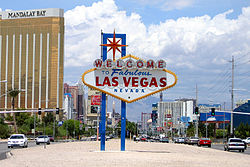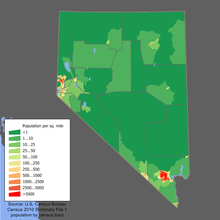„Nevada” változatai közötti eltérés
| [nem ellenőrzött változat] | [nem ellenőrzött változat] |
| 89. sor: | 89. sor: | ||
--> |
--> |
||
====Szerencsjáték és munkalehetőség==== |
====Szerencsjáték és munkalehetőség==== |
||
[[Image:LasVegasSign06212005.jpg|250px|thumb| |
[[Image:LasVegasSign06212005.jpg|250px|thumb|left|Játék kaszinók.]] |
||
<!-- |
|||
Unregulated [[gambling]] was common place in the early Nevada mining towns but outlawed in 1909 as part of a nation-wide anti-gaming crusade. Due to subsequent declines in mining output and the decline of the agricultural sector during the [[Great Depression]], Nevada re-legalized gambling on March 19, 1931, with approval from the legislature. At the time, the leading proponents of gambling expected that it would be a short term fix until the state's economic base widened to include less cyclical industries. However, re-outlawing gambling has never been seriously considered since, and the industry has become Nevada's primary source of revenue today. |
Unregulated [[gambling]] was common place in the early Nevada mining towns but outlawed in 1909 as part of a nation-wide anti-gaming crusade. Due to subsequent declines in mining output and the decline of the agricultural sector during the [[Great Depression]], Nevada re-legalized gambling on March 19, 1931, with approval from the legislature. At the time, the leading proponents of gambling expected that it would be a short term fix until the state's economic base widened to include less cyclical industries. However, re-outlawing gambling has never been seriously considered since, and the industry has become Nevada's primary source of revenue today. |
||
The [[Hoover Dam]], located outside Las Vegas near [[Boulder City, Nevada|Boulder City]], was constructed in the years 1932–1935. Thousands of workers from across the country came to build the dam, and providing for their needs in turn required many more workers. The boom in population is likely to have fueled the re-legalization of gambling, alike present-day industry. Both Hoover Dam and later war industries such as the Basic Magnesium Plant first started the growth of the southern area of the state near Las Vegas. Over the last 75 years, Clark County has grown in relation to the [[Reno]] area, and today encompasses most of the state's population. |
The [[Hoover Dam]], located outside Las Vegas near [[Boulder City, Nevada|Boulder City]], was constructed in the years 1932–1935. Thousands of workers from across the country came to build the dam, and providing for their needs in turn required many more workers. The boom in population is likely to have fueled the re-legalization of gambling, alike present-day industry. Both Hoover Dam and later war industries such as the Basic Magnesium Plant first started the growth of the southern area of the state near Las Vegas. Over the last 75 years, Clark County has grown in relation to the [[Reno]] area, and today encompasses most of the state's population. |
||
--> |
|||
====Nuclear Testing==== |
====Nuclear Testing==== |
||
A lap 2008. október 9., 21:48-kori változata
| Ebben a szócikkben még nincs vagy aránytalanul kevés a folyó szöveggel írt tartalom.
Ha kedvet érzel a bővítéséhez, és megbízható forrásaid is vannak hozzá, ne habozz! A szerkesztéshez kattints ide! |
Sablon:USA tagállam adatlap Nevada 1864-ben lett az Amerikai Egyesült Államok 36. tagállama, a kifejezés "harcban született" (Baattle Born), utal arra, hogy Nevada az polgárháború idején lepett be az Unióba. Az Államok nyugati területén helyezkedik el. Fővárosa Carson City, s legnagyobb városa Las Vegas. Az állam bece neve "az ezüst állam" ("The Silver State"), mivel sok ezüst lelő helyet fedeztek fel itt. Az első település Mormon Station volt.
Nevada a hetedik legnagyobb állam, mely magában foglalja délen a Mojave Desert-et és északon a Great Basin-t. Az állam területének megközelítőleg 86%-a az Központi kormány tulajdonában van, mind polgári, mind katonai szempontból.[1]
A 2006. évi U.S. Census felmérései alapján az államnak 2,6 millió lakosa volt, s ennek 85 %-a Las Vegas és Reno metropolisz körzetében élt. ]</ref> The state is well known for its easy marriage and divorce proceedings, legalization of gambling and, in a few counties, legalized brothels.
In 2005, the state issued a specialty license plate via the Nevada Commission on Tourism that lists the name of the state as Nevăda to help with the pronunciation problem. The local pronunciation of the state's name is not /nəˈvɑ.də/ (as in the "a" in "father"), but /nəˈvæ.də/ (as in the "a" in "glad").[2] Local residents - particularly natives of the state - resent hearing Nevada's name mispronounced in the national media, a problem that has crystallized with increased coverage of the state following the 2008 Presidential Primary Elections.[3]
Földrajz

Éghajlat
Nevadának sivatagi éghajlata van. A nyár forró, s a hőmérő higanyszála felszaladhat 43,3 Celsius fokik, s télen - 6,5 Celsius fokig. Az év folyamán a csapadék az egész állam területén kevés.
Határos államok
- Keleten Utah, délkeleten Arizona, nyugaton Kalifornia, északon Oregon és Idaho határolják.
Történet
Ipar
Szerencsjáték és munkalehetőség

Nuclear Testing
The Nevada Test Site, 65 mérföld (105 km) Northwest of the City of Las Vegas, was founded on January 11, 1951 for the testing of nuclear weapons. The site is composed of approximately 1350 négyzetmérföld (3500 km2) of desert and mountainous terrain. Nuclear testing at the Nevada Test Site began with a one-kiloton of TNT (4 terajoule) bomb dropped on Frenchman Flats on January 27, 1951. The last atmospheric test was conducted on July 17, 1962 and the underground testing of weapons continued until September 23, 1992. The location is known for the highest amount of concentrated nuclear detonated weapons in the U.S. It is also the home of Area 51.
Over 80% of the state's area is owned by the federal government. The primary reason for this is that homesteads were not permitted in large enough sizes to be viable in the arid conditions that prevail throughout desert Nevada. Instead, early settlers would homestead land surrounding a water source, and then graze livestock on the adjacent public land, which is useless for agriculture without access to water (this pattern of ranching still prevails). The deficiencies in the Homestead Act as applied to Nevada were probably due to a lack of understanding of the Nevada environment, although some firebrands (so-called "Sagebrush Rebels") maintain that it was due to pressure from mining interests to keep land out of the hands of common folk. This debate continues to be argued among some state historians today.
Demographics
| Népesség különböző években | |||
|---|---|---|---|
| Év | Népesség | Vált. (%) | |
| 1860 | 6 857 | ||
| 1870 | 42 941 | 526,2% | |
| 1880 | 62 266 | 45% | |
| 1890 | 47 355 | −23,9% | |
| 1900 | 42 335 | −10,6% | |
| 1910 | 81 875 | 93,4% | |
| 1920 | 77 407 | −5,5% | |
| 1930 | 91 058 | 17,6% | |
| 1940 | 110 247 | 21,1% | |
| 1950 | 160 083 | 45,2% | |
| 1960 | 285 278 | 78,2% | |
| 1970 | 488 738 | 71,3% | |
| 1980 | 800 493 | 63,8% | |
| 1990 | 1 201 833 | 50,1% | |
| 2000 | 1 998 257 | 66,3% | |
| 2007 (becsült) | 2 565 382 | ||

A U.S. Census Bureau 2007. évi felmérése szerint Nevada lakossainak száma 2 565 382 fő volt, mely az előző évvel összevetve 92 909 fővel növekedett, százalékban kifejezve 3,5%-ot nőtt. Ha a 2000.évi adatokat vesszük alapul a lakosság száma 516 550 fővel nőtt, amely 20,8 %-os növekedés jelent. Ez magában foglalja a természetes növekedést is, ahol a születések száma 170 451 fő, a hatálozások száma 81 661 fő, s az ujjonnan letelepedettek száma 337 043 volt. A 2006-os becslések alapján Nevada a második leggyorsabban növekvő állam lakosságát illetően.[4]
Las Vegas az Államok leggyorsabban növekvő városa.
Vallás
Nevada állam lakosainak vallás szerinti megoszlása:[5]
- Római katolikus – 27%
- Protestáns; 11 %
- Evangélikus – 13%
- Más protestáns – 2%
- Mormon – 11%
- Muszlim – 2%
- Zsidó – 1%
- Más vallás – 1%
- Nem válaszolt – 20%
A legnagyobb számú felekezet a 2000. évi tanulmányok alapján a római katolikus egyház, tagjainak száma 331 844, a Church of Jesus Christ of Latter-day Saints 116 925; és a déli babtista felekezet 40 233 taggal. 77 100 nevadai a zsidó egyházközösséghez tartozik.[6]
Történet
Gazdaság
Népesség
Nevezetességek
Jegyzetek
- ↑ Nevada Natural Resources Status Report
- ↑ Although the name is derived from the Spanish word Nevada, which is the feminine form of "covered in snow," it is common for Spanish-derived place names in the United States to be no longer pronounced by native English speakers in a manner which reflects the name's Spanish roots (the pronunciation of the name "Los Angeles," for instance, is commonly accepted as "Los An-JELL-es" not "Los An-HELL-es" by native English speakers).
- ↑ Griffith, Martin. „It's Nuh-VAD-uh, not Nuh-VAH-duh”, Las Vegas Review-Journal, 2008. január 18. (Hozzáférés ideje: 2008. január 31.)
- ↑ CNN
- ↑ Pew Forum on Religion & Public Life
- ↑ http://www.thearda.com/mapsReports/reports/state/32_2000.asp

